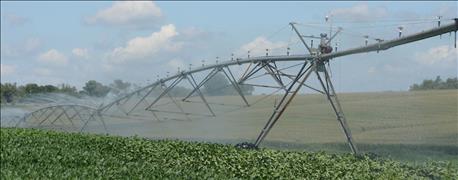
Water is one of Nebraska agriculture's most vital resources. The state has over 8 million acres of irrigated land, according to most recent USDA Ag Census data. That's more irrigated acres than any other state in the U.S. While water is, for the most part, in ample supply in Nebraska, there's also a strong demand for water across multiple interests.

BALANCING EVERYONE'S NEEDS: "As we move forward with this program, I think we'll be surprised at the possible benefits we see from the municipal side, the ag side, and the environmental side," Vogt says. "We're looking at this as a way to balance everyone's needs by retiring the least amount of acres possible while staying sustainable."
"We can buy irrigated acres and retire them, but those are permanent easements. Permanent is quite a while," says Lyndon Vogt, general manager of Central Platte Natural Resources District. "Rather than taking some of the most productive agricultural land in the world out of production, knowing that our population is going to reach 9 billion by 2050, we started thinking, maybe there's a better way to do this."
That's why Central Platte NRD, which includes parts of Custer, Buffalo, Dawson, Frontier, Hall, Howard, Merrick, Hamilton, Nance, Polk, and Platte counties, is developing a groundwater exchange program to be implemented starting as soon as possible.
The process will use a computer program that matches up buyers and sellers each year for an annual exchange – usually in a two-to-three-week time frame. So, sellers can come to the market and offer the acres they're willing to give up, and the minimum price they're willing to accept for that water. Meanwhile, buyers enter how many acres they want to irrigate and the maximum amount they're willing to pay, and the program matches them up, while ensuring there are no negative effects on the Platte River, explains Vogt.
As part of the exchange, the seller's irrigated acres must be left idle. Being more water use efficient doesn't necessarily mean less water is used – the same amount of water is required to grow a corn crop, regardless of the application method.
For example, if a farmer were converting 160 acres from gravity irrigation to 130 acres of pivot irrigation, they have the option to now exchange the remaining 30 acres on an annual basis, allowing another farmer to put those acres to use. Or if a farmer were simply willing to leave acres idle for a season, he or she could exchange those acres, allowing another farmer access to more irrigation. And it isn't just farmers that can get involved. Environmental groups will likely be interested in buying acres producers are willing to leave idle to put water back into the river for environmental purposes.
"We might have someone that has an irregular shaped field or that has to lay a lot of pipe to irrigate a field and decides they don't want to deal with the hassle. If they could make a little extra money, they would let someone else use those acres. I see those farmers coming to the table as sellers of water," Vogt says. "In the future, because the NRD has to put water back in the river too, it's very possible we could have a third party manage the program so we could be a buyer as well."
"As we move forward with this program, I think we'll be surprised at the possible benefits we see from the municipal side, the ag side, and the environmental side," Vogt adds. "We're looking at this as a way to balance everyone's needs by retiring the least amount of acres possible while staying sustainable."
To learn more about the Groundwater Exchange Program, contact Vogt at [email protected].
About the Author(s)
You May Also Like






